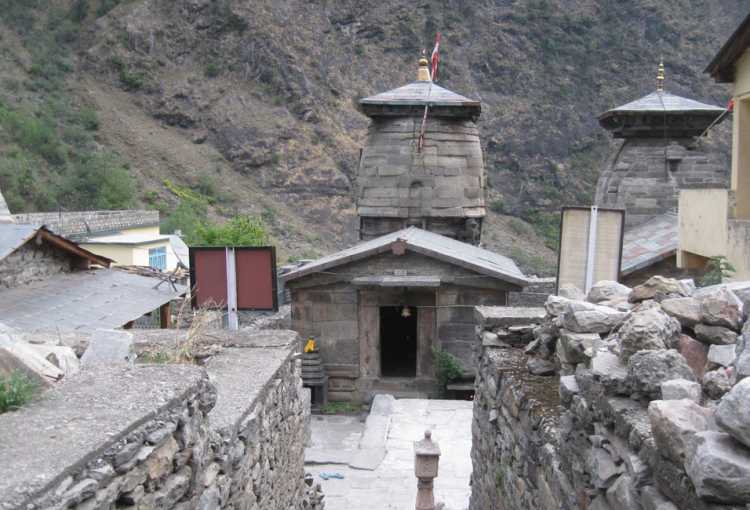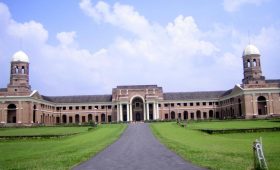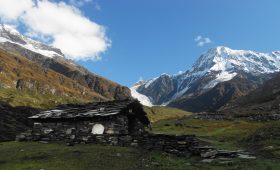Uttarakhand also known as the land of Gods is the perfect destination for all the fervent tourists and Hindu pilgrims thronging from India as well as overseas. It is indeed a beautiful place that holds the rich beauty of the Himalayas and Mother Nature. Gentle breeze, lofty mountain challenges, pleasant ambience and snowfall of Uttarakhand give every traveler a feeling of being stepped into a paradise. If you are a true devotee of the goddess, then there is a plethora of ways to connect yourself with the heavenly nature. The highly admired one among all is Panch Badri Yatra, taking one on a spiritual tour to the five Badris of Badrinath where devotees pay homage to Lord Vishnu.
Details about Panch Badri
There are thousands of temples in Uttarakhand and citing the most important ones is no easy task. Even if one were to make a list of the most important Hindu temples in the state, the list would be a lengthy one. But commanding utmost respect among them are the Panch Badri temples – the five major homes of God Vishnu, which are located in various hilly villages in Uttarakhand and receive heavy pilgrim-traffic. These are Vishal Badri, Yogdhyan Badri, Bhavishya Badri, Vridha Badri and Adi Badri.
India is filled with Vishnu Temples, and in every state, you might just find one beautiful Vishnu Shrine. However, the Panch Badri is something so different and so important that you will find yourself admiring the whole journey and not just the temples. It holds a different kind of pedestal in the Indian Religious scenario.
Badri is another name for the Hindu god Vishnu, who preserves or sustains life on earth. There may be countless Vishnu temples in India, but the Panch Badri temples are five prominent temples dedicated to him in the State. They are situated at various places and are important for various reasons.
The details of Panch Badris are given here below; you can check it out and know more about the temples you are going to visit.
Vishal Badri:-
Badrinath Dham is also known as Vishal Badri, this temple located at the height of 3,133 mts. is the largest Himalayas and most popular of Vishnu pilgrimages among the five Badries. The original temple here is believed to be built by King Pururava and the icon of the lord carved by Vishwakarma, the creator of the gods. The idol was recovered by Adi Shankaracharya from the waters of the nearby Naradkund and consecrated once more in the temple, restored in the 19th century by the royal houses of Scindia & Holker. So holy in these shrines that it forms one of the four prominent places of Hindu worship. The epic Mahabharata, it is believed, was composed in the Vyas and Ganesh caves close by. The Vishnu Ganga which later becomes Alaknanda flows below, the while Neelkanth keeps vigil over all devotees.
The famous two hot springs Tapt Kund and Surya Kund maintain the temperature of 500 C round the year. Moreover, visitors can take a bath in these hot springs before heading for a Darshan to cleanse the soul and body.
How to Reach Badrinath:-
Badrinath Dham is located in Chamoli Garhwal District; you can reach here by roads transport. Badrinath is approx. 326 Km from Haridwar, where you can reach via roads transport, Train and flight. The temple is located in the town, so no need of trekking. The nearest Airport is Jolly Grant Dehradun.
Yogdhyan Badri:-
Though Vishal Badri, or Badrinath, is the most popular of the Panch Badri, it still cannot accommodate pilgrims throughout the year. When winter brings heavy snowfall in the upper Himalayan region, this temple becomes inaccessible. So during these winter months, the black stone idols of Vishnu kept in the Badrinath temple are moved to Yogdhyan Badri in Pandukeshwar, about 24km away from Vishal Badri.
Yogdhyan literally means ‘meditating’ and the temple depicts Vishnu in a meditative state. Pandukeshwar village thus becomes the winter seat of Badrinath. If the name Pandukeshwar doesn’t ring a bell, then it is probably time to brush up on your Mahabharata knowledge. King Pandu, father of the Pandvas, lived in this village and rigorously meditated to lift a sage’s curse. Since Vishnu was the god who answered his prayers, the name Pandukeshwar and Yogdhyan Badri stuck.
How to Reach Yogdhyan Badri:-
It is a good idea to visit Yogdhyan Badri to experience the peace and serenity. It is located at a height of 1920m, it gives a breathtaking view of the mountains, and the picturesque Surya Kund is also nearby. Pandukeshwar is 275 km from Rishikesh and can be reached by private jeeps, hired cars or buses.
Bhavishya Badri:-
It is said to be the next abode of Lord Vishnu, and almost alluding to that is the very fact that the temple is aptly named Bhavishya which means Future. According to the popular legends, the next era will see Lord Vishnu making this his new seat as the two monitions Nar and Narayan will break and block all paths to Badrinath Temple. At that time, Vishnu will reappear in Bhavishya Badri, which is located at a height of 2744m and is 12 km away from Joshimath.
How to Reach Bhavishya Badri:-
Bhavishya Badri can be reached easily by hire taxi from Joshimath bus stand till Subain and further by trek. Nearest rail connectivity is at Dehradun (294 kms) or Rishikesh railway station (256 kms). Jolly Grant Airport, Dehradun (272 kms) is the only airport to reach near Joshimath.
Vridha Badri:-
Before Badrinath was designated one of the four Char Dhams of Hindu worship by Adi Shankaracharya, the idol of Badrinath carved by divine Vishwakarma was enshrined and worshipped here. It is said that when mankind entered the age of Kali, Vishnu chose to remove himself from the temple. Interestingly the image was found by Adi Shankaracharya at Narad Kund, and restored, through part of it remains damaged. This, the first Badri, is located at the height of 1,380 mts. at Animath. While Badrinath closes during winter, the idol and priests hibernating at Joshimath, Virdha Badri remains opens throughout the years.
How to Reach Vridha Badri:-
It is located at a height of 1380m in Animath, which is a 7 km-trek from Joshimath and around 280 km from Rishikesh. It is situated ahead of Kalpeshwar Mahadev Temple, ahead in Helang. The Nearest Airport is Jolly Grant Airport Dehradun.
Adi Badri:-
Adi means ancient or bygone. So Vishnu’s seat in the bygone era was Adi Badri, which is situated at a height 1875m. There are 16 temples of all sizes and their height varies from 2m to 6m, with the tallest one belonging to Vishnu. Though many attribute the construction of these temples to Gupta period, there are others who believe that Adi Shankaracharya, who worked tirelessly to spread Hinduism in the country, was the one who built these. A short drive from here will take you to Chandpur fort which was used to fight the British by the Gurkha rulers. There are many places around Adi Badri which are an adventurer’s delight. Trekking trails are in abundance and the forests are full of rich Himalayan flora and fauna.
The main temple is dedicated to Narayan and has a raised platform in the pyramidal form. Within the temple, a black stone idols installed. It is believed that these temples, dating to the Gupta age , was sanctioned by Adi Shankaracharya who wanted to spread the tenets of Hinduism to every remote corner of the country.
How to Reach Adi Badri:-
Adi Badri is located 18 Km from Karanprayag on the way to Ranikhet. It is accessible by road transports. The nearest Airport is Dehradun and Railway Station is Rishikesh & Haridwar.
Best Time to Visit the Panch Badri Temple:-
All the Panch Badri Temples can be visited during the Summer Season means May to Nov, after that Badrinath Dham closed due to heavy snow falls and then you can visit other Four Badri temples.
Duration to Visit Panch Badri Temple:-
If you want to cover all the Panch Badri Temples then it can be visited in 6 Days from Haridwar to Haridwar.
Itinerary for Panch Badri trip:-
Day 01: Haridwar – Rishikesh – Joshimath (280 km/8-9 hrs approx).
Post Breakfast, you can start Journey for Joshimath.
Day 02: Joshimath – Vishnuprayag – Badrinath Jee (46 km/2-3 hrs approx).
After breakfast, proceed to Badrinath, on the way visit Vishnuprayag sangam. Later continue to Badrinath ji.
Day 03: Badrinath Ji – Pandukeshar – Yogdhyan Badri – Joshimath (44 km/2 hrs approx).
After breakfast, proceed to Joshimath, on the way visit Yogdhyan Badri Temple. Later continue to Joshimath.
Day 04: Joshimath – Syaldhar – Bhavishya Badri – Joshimath (12 km drive & 06 km trek-one side).
After breakfast, proceed to Syaldhar. Reach Syaldhar and start trek to Bhavishya Badri. On arrival at Bhavishya Badri, visit the Narsing temple and Shankaracharya temple, later back to Joshimath.
Day 05: Joshimath – Virdha Badri – Adi Badri – Rudraprayag (92 Km/2-3 hrs approx.).
After breakfast, proceed to Virdha Badri & Adibadri via Karanpryag.
Day 06: Rudraprayag – Haridwar Drop.
After breakfast, proceed to Haridwar. Drop at Haridwar and tour terminates.
So these are the Panch Badri Temples you can visit in 6 days if you start from Haridwar. You can book a trip from us Gokeys Haridwar and grab the best deal for your journey.



